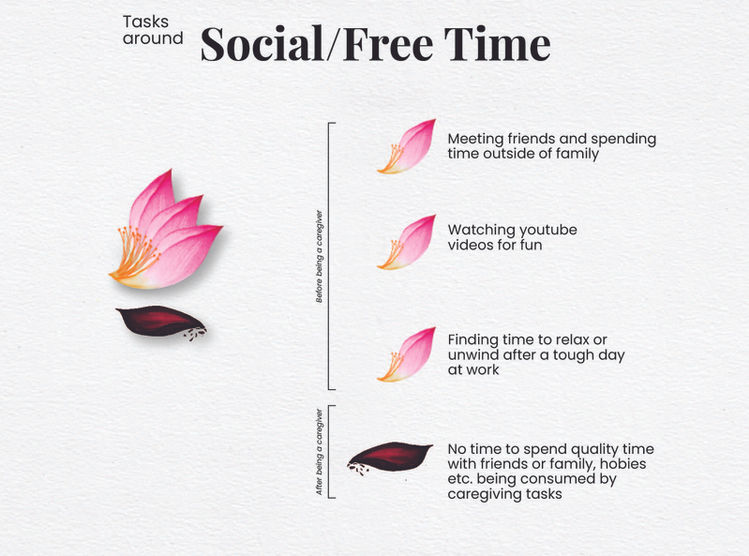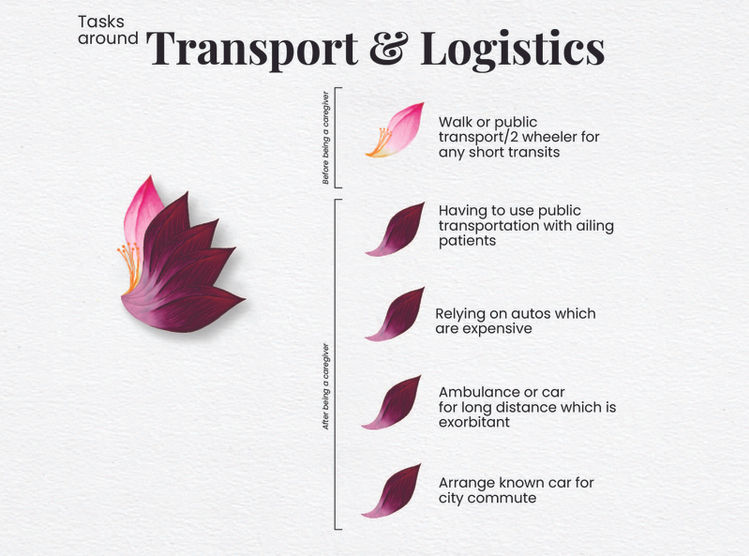
How might we communicate the caregiver’s experience beyond statistics, in ways that evoke empathy, inspire advocacy, and drive systemic change?
2023
The Caregiving Lab, Noora Health
team
Manju Pothem
Charley Vincent
role
design research, visual communication
Overview
A design research initiative aimed at exploring the experiences, challenges, and support available to caregivers of people with high-risk, life-threatening conditions. These included cancer, heart diseases, life-altering accidents, congenital conditions, and other areas that require intensive treatment and long-term care.
During this project, we identified several interrelated areas where caregivers felt their lives had changed dramatically, post embarking on their caregiving journey. We knew we had to talk more about this for thought leadership and advocacy. We called this - The Caregivers Load.
Key Role
-
Led design research: Designed and conducted in-depth interviews with caregivers, developed research tools, and synthesized qualitative data into key insights.
-
Conducted fieldwork: Personally led interviews, capturing emotional, financial, and systemic shifts in caregiving journeys.
-
Led visual communication: Conceptualized and created emotionally resonant visualizations and based on real research to communicate caregiver experiences.
-
Advocated for story-driven communication: Pushed for formats that went beyond statistics, ensuring outputs were both research-rooted and emotionally accessible.




The Caregivers Load
Urban Interviews
Rural Group Session
Co-creation Session
Objectives
1. To Deepen Our Understanding of the Caregiving Experience
While caregiving has long been studied from a medical or institutional lens, our goal was to re-center the caregiver—not as a passive bystander in the patient’s journey, but as someone undergoing their own parallel transformation. We wanted to understand:
-
What changes for caregivers emotionally, socially, and financially?
-
How does the health system recognize or overlook their needs?
-
What kinds of informal or formal support help them stay afloat?
2. To Spark Broader Dialogue and Advocacy
Caregivers often go unseen and unheard in health narratives. We aimed to bring visibility to their stories in a way that would resonate with policymakers, designers, healthcare professionals, and the wider public beyond statistics.
Visualising The Load Of Caregiving
Translating the richness of our findings proved challenging. When it comes to qualitative insights, graphs and maps only convey so much, obscuring many of the human subtleties and nuances. And so, we set out to understand alternative ways to best communicate the wealth of data from our observations and interviews without losing the complexity and emotions that were shared by each caregiver.
We presented the data in an easily digestible format, while also stirring emotion. To do this we decided to leverage data humanism — a form of presenting data that involves linking numbers to relatable concepts and behaviors that encompass the subjective and imperfect aspects of human experience. Simply put, data humanism blends quantitative analysis with a focus on uncovering the human narratives embedded within the data.
Explorations: In our various explorations, we saw parallels between the load of caregiving tasks affecting caregivers and the impact weeds and thorns have on flourishing flower petals. After several rounds of sketching and feedback, we narrowed in on a visualization with three distinct units, each conveying a unique aspect of our findings.

from my sketchbook
In our various explorations, we saw parallels between the load of caregiving tasks affecting caregivers and the impact weeds and thorns have on flourishing flower petals. After several rounds of sketching and feedback, we narrowed in on a visualization with three distinct units, each conveying a unique aspect of our findings.

Legend
The data visualization was shared at multiple conferences and events. The overwhelming feedback we received was that the analogy to a flower petal allowed people to relate to the load a caregiver carries, at a much deeper level.








